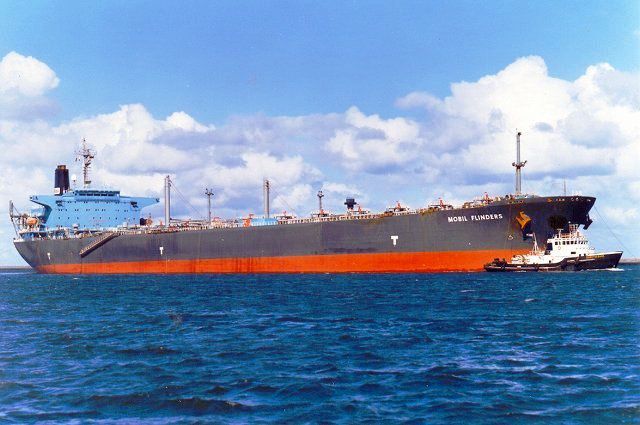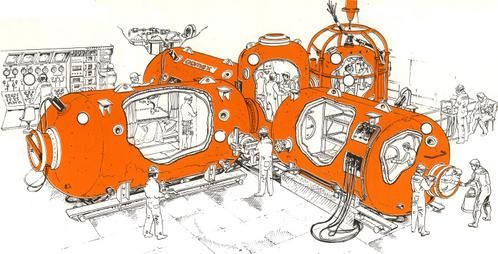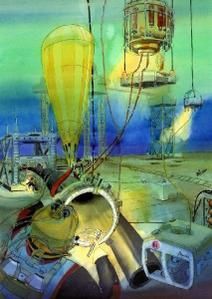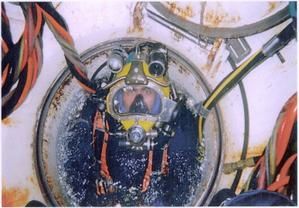Photo : Pétrolier sur sa bouée
Fin 93, Coup de fil de Marseille. La grande maison me propose un poste de Mooring Master Supervisor au Cameroun pour remplacer le vieux Raymond qui partait à la retraite.
MMS, ce titre sonne pas mal, répondis-je, mais je ne sais pas du tout en quoi cela consiste.
Bof tu verras, me dit mon interlocuteur, c’est un boulot super cool qui consiste à monter sur les pétroliers et à ensuite les diriger sur une bouée de chargement en pleine mer pour les ravitailler en brut.
Et pour la mise au courant, ne t’inquiètes pas, tu travailleras en double pendant les 2 premières semaines avec Jean-René qui te brieferas sur ce travail particulier.
Ouais mais la plongée dans tous ça rétorquais-je ?
Pas de panique, en plus des pétroliers, tu auras aussi à t’occuper de la maintenance en surface et sous eau des 2 bouées de chargement du terminal de Kolé.
Comme il commençait à y avoir pas mal de grand changement au sein de la firme et que les chantiers de plongée avaient l’air de diminuer, je m’empressai d’accepter, surtout qu’encore une fois, ce type de chantier allait me permettre d’à nouveau avoir des rotations régulières mieux adaptées à ma vie familiale.
Si bien qu’une fois de plus je me retrouvai quelques jours plus tard à Douala.
A l’inverse, d’autres endroits en Afrique, cette ville était assez agréable et à l’exception de quelques endroits où il valait mieux ne pas se promener seul, l’insécurité n’y était pas trop élevé puisque au cours de mes différents séjours je n’y avais subit qu’une seule agression avec tentative de vol.
Etant arrivé à l’aéroport en début de soirée, j’appris que mon départ en mer n’était prévu que pour le lendemain matin et donc une chambre à l’hôtel IBIS m’avait été réservée ce qui je dois bien le reconnaître était bien plus agréable que d’être immédiatement transféré vers la barge via l’un ou l’autre bateau inconfortable sur lequel il fallait parfois passer plusieurs heures sans même avoir droit à la moindre collation.
Ici au moins je pouvais dîner à l’aise, prendre un dernier verre au bar avant de quitter la civilisation pour les 8 semaines à venir et profiter d’une dernière bonne nuit de sommeil.
Quant je dis passer une bonne nuit de sommeil, je dois dire que j’exagère un peu car bien qu’étant très confortable, cet hôtel était malgré tout assez bruyant.
Souvent au cours de la nuit on entendait dans les couloirs un « toc toc toc » sur l’une ou l’autre porte suivi bien naturellement de « qu’est-ce que c’est ? »
La réponse elle, était toujours la même « c’est l’amour qui frappe à la porte »
Evidemment, la première fois cela que cela m’arriva, je fus quelques peu surpris.
Mais, maintenant, connaissant ce type de coutume locale, je prenais soin de toujours d’amener avec moi, ma boite de …..boules Quiès, ce qui me permettait malgré tout de ne pas être trop perturbé par les allées et venues de ces charmantes dames.
Le lendemain matin, en route pour le port où j’embarque ainsi que d’autres travailleurs locaux sur une vedette rapide qui va nous emmener sur le site.

Quelques heures plus tard, me voilà sur le tanker tampon SEREPCA à bord duquel m’attend JR, Bruno et ses collègues africains.

Après les présentations d’usage au tonton et les divers membres d’équipage, direction ma cabine.
Hé pas mal du tout, une cabine d’officier spacieuse avec bureau et petit salon pour moi seul, cela change des cabines merdiques de certaines barges pourries que j’avais déjà connu.
Très rapidement, JR me met au parfum, ici, nous sommes sur un navire de la marine marchande et les règles à bord sont celles de la marine ce qui signifie un peu plus de discipline et de tenue que sur nos barges à plongeurs où on n’arrête parfois pas de déconner.
A bord, continua-t-il même pour dîner, il y a un rituel à respecter.
Personne à table avant le Commandant et surtout, on respecte les places de chacun.
Au début, je me pliai comme tout le monde à cette dernière règle, mais un peu plus tard après avoir été bien intégré au sein de cette communauté de marins, j’éprouvai un malin plaisir à changer de place plusieurs fois par mois au grand désarroi des personnes concernées.
Au cours des jours suivants, mon binôme m’initia à ma nouvelle mission qui comme cité plus haut consistait entre autre à remplir les tankers qui arrivaient lège sur le champs.
Comme on peut l’imaginer, remplir un tanker n’est pas aussi aisé que faire le plein de sa voiture.
Pour nous, il fallait d’abord aborder le navire en pleine mer pour y acheminer tout le matériel dont nous avions besoin.

Une fois à bord tandis que le navire continuait sa route vers la bouée, nous disposions d’environ une demi-heure pour préparer le matériel d’amarrage, de relevage et de connexion des gros et lourds flexibles de chargement.

Puis en approchant de la bouée, le rôle du MMS, donc le mien, consistait à se placer à l’avant du bateau et à via le walky talky, donner mes instructions au commandant pour le guider très précisément au cours de son approche finale jusqu’à ce qu’il s’arrête pile à quelques mètres de la bouée de chargement.

Ensuite, une fois le navire amarré sur la bouée, les deux gros flexibles de chargement étaient hissés à bord pour être connectés aux manifolds de chargement, ce qui permettait alors de faire le plein des citernes en une vingtaine d’heures.

Comme prévu, Jean René rentra en France au bout de deux semaines et autant dire que la première fois que je fus seul pour accomplir cette tâche, je suais non pas de chaleur, mais bien de trouille parce qu’il ne fallait pas que je me loupe.
Si tel était le cas, deux scénarios étaient possibles.
Soit le pétrolier passait à coté de la bouée et s’arrêtait un peu trop loin, ce qui signifiait alors qu’il était bon pour refaire une nouvelle approche, ce qui voulait dire au minimum une heure de perdue, soit il rentrait dans la bouée, arrachait le tout ce qui signifiait alors que moi j’étais viré.
Heureusement, au cours de mes divers séjours, j’appris rapidement à savoir comment réagissaient ces énormes mastodontes de 150.000 à 200.000 tonnes et parvins à chaque fois à les mener à bon port.
La fréquence des navires étaient assez aléatoire, ce qui permettait alors de travailler entre les chargement sur les bouées de KLB1 et KLB2.

Chaque bouée, avait un programme d’entretien très complet qui se passait aussi bien au dessus qu’en dessous de l’eau.
Sous eau, la tâche principale des plongeurs consistait à vérifier l’état et la configuration des gros flexibles qui partaient du fond via le PLEM (Pipeline End Manifold) et arrivaient sous la bouée, de même que l’état et la configuration des six énormes chaînes qui maintenaient la bouée en position.

Les plongées d’inspection sur le fond, réservaient parfois quelques surprises car la visibilité y était souvent très limitée et dès lors, il était assez fréquent de se faire mordiller les doigts par quelques petites murènes qui se vengeaient d’être dérangée par nos inspections tactiles.
Un autre problème de visibilité que nous rencontrions parfois sur le champ, mais en surface cette fois était du à l’harmattan.
Celui-ci était un vent chaud et poussiéreux qui provenait du Sahara et qui durant plusieurs jours de suite pouvait obscurcir l’atmosphère.
Le 2 février 94, nous étions partis depuis le matin pour aller faire les entretiens sur la bouée KLB2 qui se trouvait à environ 20 minutes de zodiac de notre tanker tampon.
La visibilité n’était pas terrible, mais elle était largement suffisante pour repérer la bouée à mi chemin.
La matinée passa relativement vite et comme midi approchait, je décidai d’arrêter les travaux et de rentrer dîner.
Très vite pourtant, nous nous rendons compte que l’atmosphère est devenue extrêmement chargée et on n’y voit plus à 50 m.
Qu’à cela ne tienne, le SEREPCA est assez grand et on ne peut pas le raté.

Donc full speed et cap au Nord.
Une vingtaine de minutes plus tard, tout le monde est aux aguets et scrute l’horizon afin de détecter la masse du tanker, mais rien en vue, juste cette sorte d’épais brouillard qui nous empêche de voir quoi que ce soit.
Normalement, nous ne devrions pas être loin pensais-je car nous avions navigué à peu près à la même vitesse et durant la même période de temps qu’à l’aller.
Donc je demandai au plongeur pilote de bien vouloir mettre le cap au NNE à petite vitesse pendant une minute.
Rien, pas le moindre bateau.
Idem au NNO, crottes de bique, toujours rien.
Bon les gars on va stopper ici dis-je, pas la peine de risquer de s’éloigner plus.
Je vais appeler le bateau et demander qu’ils actionnent la corne de brume ainsi nous saurons nous diriger au son.
SEREPCA, SEREPCA, SEREPCA : zodiac plongeur !
SEREPCA, SEREPCA, SEREPCA : zodiac plongeur !
SEREPCA, SEREPCA, SEREPCA : zodiac plongeur !
Rien aucune réponse du tanker.
Je regardai ma montre. 12h10, pas la peine d’insister, ils sont sans doute tous à table.
Que faire, nous n’allions tout de même pas attendre qu’ils aient terminé la sieste pour les rappeler.
En principe, notre supply d’assistance le « Cristal fish » devait être quelque part sur le champ et dès lors, je me décidai à l’appeler.
Un seul appel suffit pour avoir le radio en ligne.
Immédiatement, je lui demandai de bien vouloir me passer son supérieur.
Deux minutes plus tard celui-ci arriva à la radio.
Bonjour Commandant ici Francis.
Dites, nous avons un petit problème, nous sommes égaré.
Est-ce que vous vous trouvez à proximité du SEREPCA ?
Non, nous sommes à coté de la BOS.
Ah merde, donc pas la peine de faire sonner la corne, car même si on l’entendait, cela ne nous entraînerait pas dans la bonne direction.
Aussitôt je demandai :
Est-ce que vous pouvez essayer de nous repérer sur le radar ?
OK une minute, je regarde.
Non je ne vois rien à l’écran, faites un 360 ° à faible vitesse pour voir.
Sorry toujours rien.
Cela devenait gênant, évidemment nous avions assez d’essence pour rejoindre la terre qui devait se trouvait à environ deux heures de route, mais nous aurions pu accoster n’importe où avec les risques que cela comporte.
Pendant que je réfléchissais comme me dépêtrer de ce merdier, une idée me vint.
Pendant mon séjour chez les plongeurs démineurs quelques décennies plus tôt, nous avions sur nos embarcations de plongée un déflecteur qui permettait au radariste de nous emmener sur les contacts suspects.
Donc, ici, pourquoi ne pas faire la même chose.
Problème, nous n’avions pas de déflecteur dans notre canot.
Pas de déflecteur, ok, mais nous pouvions peut-être en fabriquer un ?
Nous avions déjà deux pagaies qui pouvaient servir de mats.
Restait à trouver de quoi faire le déflecteur.
Avons-nous des fumeurs à bord ?
Ouf, oui, Hervé et Eke.
Bon désolé les gars, pouvez-vous vider vos paquets de cigarettes et me donner les emballages.
Rapidement ils s’exécutèrent mais me regardèrent bizarrement lorsque je déchirai les paquets et les retournai de manière à avoir l’aluminium à l’extérieur.
J’avais maintenant le matériau réfléchissant.
Ne restait plus qu’à trouver un support et quoi de mieux que mon petit sac à dos.
Très rapidement l’aluminium fut scotché sur mon sac, puis ce dernier monté sur les pagaies.
Ca y est, nous avions un semblant de déflecteur.
Je rappelai le Cristal Fish.
Commandant, nous avons fabriquer un déflecteur, pouvez-vous regarder si vous avez un contact ?
Allez y zodiac, mettez en route lentement.
Lentement, notre bateau se mit en route. Pourvu que cela marche pensais-je.
Quelques secondes plus tard, nouvel appel radio.
Zodiac : Cristal fish.
Ca y est, je vous ai repéré vous êtes à un demi mille de votre destination.
Partez au cap 105 je reste en contact et vous guide.
10 minutes plus tard, notre tanker était en vue.
Aussitôt je remerciai le tonton du supply de son assistance.
Une fois a bord, je vis que le Commandant avait sa tête des mauvais jours.
Il nous dit froidement.
Messieurs, la prochaine fois ayez la politesse de bien vouloir arriver à l’heure à table.
Ah ça, il ne manque pas de toupet celui-la pensais-je sans faire de commentaire.
A part ce petit incident, rien d’autre de particulier ne m’arriva au cours des quatre rotations que je fis sur ce bateau.
Le travail me plaisait assez mais il n’y avait pas assez de plongée à mon goût.
De plus, mon « petit » qui avait maintenant 24 ans et que je n’avais pas toujours vu grandir, avait quitté le nid familial.
Ma douce moitié elle supportait de moins en moins mes séjours à l’étranger et me supplia d’arrêter.
Résultat, en ce triste jour du 19 août 94 je me résignai à donner ma démission à cette entreprise où j’avais eu l’occasion de vivre une extraordinaire aventure pendant environ 16 années.
La suite de ma carrière professionnelle un peu moins palpitante, continua par un incident de parcours durant lequel on tenta durant neuf mois de m’initier à certaines pratiques auxquelles je n’adhérais pas.
Après m’être encouru de là, je repris contact avec le fils de mon premier employeur qui avait à son tour repris les affaires de son père, et fut tout heureux de m’embaucher.
Aujourd’hui, je suis toujours dans le métier, mais conformément aux prédictions que m’avait faites un marin Indien en 1983 je passe maintenant une bonne partie de mon temps au bureau où je suis choyé par la gent féminine qui y travaille.
Papy One
Conclusion : Vive la Marine.
Photos internet



/image%2F1488399%2F20150730%2Fob_f0bf99_oh-les-beaux-yeux.jpg)
/image%2F1488399%2F20150730%2Fob_8e67a6_2.jpg)
/image%2F1488399%2F20150730%2Fob_41d354_3.jpg)
/image%2F1488399%2F20150730%2Fob_d5ec42_4.jpg)
/image%2F1488399%2F20150730%2Fob_2c8ec7_5.jpg)
/image%2F1488399%2F20150730%2Fob_3eadb7_6.jpg)






/image%2F1488399%2F20150709%2Fob_fa3c47_1.jpg)
/image%2F1488399%2F20150709%2Fob_1d82e3_2.jpg)
/image%2F1488399%2F20150709%2Fob_d32e33_3.jpg)
/image%2F1488399%2F20150710%2Fob_d3b977_4.jpg)
/image%2F1488399%2F20150710%2Fob_d68462_5.jpg)
/image%2F1488399%2F20150710%2Fob_fd07c1_6.jpg)
/image%2F1488399%2F20150710%2Fob_77683e_7.jpg)
/image%2F1488399%2F20150710%2Fob_3e20c6_8.jpg)
/image%2F1488399%2F20150519%2Fob_fb4633_photo-1.jpg)
/image%2F1488399%2F20150519%2Fob_41df4c_photo-2.jpg)
/image%2F1488399%2F20150519%2Fob_e2d619_photo-3.jpg)
/image%2F1488399%2F20150519%2Fob_bddc4e_photo-4.jpg)
/image%2F1488399%2F20150519%2Fob_49d4a4_photo-5.jpg)
/image%2F1488399%2F20150519%2Fob_235f2d_photo-6.jpg)
/image%2F1488399%2F20150519%2Fob_7d3d3b_photo-7.jpg)
/image%2F1488399%2F20150519%2Fob_fba0d4_photo-8.jpg)
/image%2F1488399%2F20150519%2Fob_f3f83b_photo-9.jpg)
/image%2F1488399%2F20150519%2Fob_c95e1a_photo-10.jpg)
/image%2F1488399%2F20150519%2Fob_14da66_photo-11.jpg)
/image%2F1488399%2F20150519%2Fob_410590_photo-12.jpg)
/image%2F1488399%2F20150519%2Fob_c514b5_photo-13.jpg)
/image%2F1488399%2F20150519%2Fob_f0c9c7_photo-14.jpg)
/image%2F1488399%2F20150519%2Fob_fd3ba9_photo-15.jpg)
/image%2F1488399%2F20150519%2Fob_e9e91c_photo-16.jpg)
/image%2F1488399%2F20150519%2Fob_83ec6b_photo-17.jpg)
/image%2F1488399%2F20150519%2Fob_0d58fe_photo-18.jpg)
/image%2F1488399%2F20150519%2Fob_9cd8de_photo-19.jpg)
/image%2F1488399%2F20150519%2Fob_55b727_photo-20.jpg)